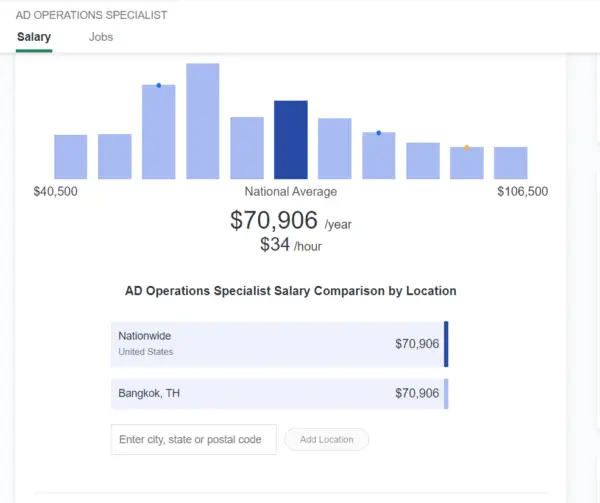Starting a career in remote Ads Operations can be an incredibly fulfilling and rewarding career path. Remote work allows professionals in the advertising industry to work from anywhere in the world, increasing efficiency, productivity, and flexibility. But with great power comes great responsibility, and being a remote ads operations professional requires a specific set of skills and practices to be successful.
In this blog post, we will dive into the key components of being a remote ads operations professional, including the job responsibility and steps in becoming one. We will also discuss the skills as well as tools and software you need to get the job done. So if you are looking to transition from being an in-office ad operations professional to working remotely or just starting as a career, this guide will provide valuable insights to help you thrive as a remote ads operations professional. So let’s dive in!
Remote Ad Operations: Job Responsibilities
Before we dive a little further let’s clarify the responsibility of a remote Ad Operations job responsibility to get a better understanding of what is required. Simply put, remote Ad Operations typically refers to the process of managing and optimizing digital advertising campaigns, but from a remote location. Remote Ad Operations professionals work behind the scenes to ensure that ads are delivered correctly, monitored for performance, and optimized to achieve the best results.
Some of the key responsibilities of Remote Ad Operations may include:
- Campaign setup and trafficking: Setting up advertising campaigns, ensuring that all creative assets are correctly uploaded, and configuring targeting options.
- Ad tracking and reporting: Monitoring ad performance and producing reports to track key metrics such as click-through rates, conversion rates, and ROI.
- Optimization: Analyzing campaign performance data and making adjustments to targeting, creative, or other factors to improve performance.
- Troubleshooting: Identifying and resolving issues with ad serving, tracking, or other technical issues that may arise.
- Communication: Collaborating with internal and external stakeholders to ensure that campaigns are aligned with business goals and communicating performance updates to stakeholders.
8 Digital Marketing Strategies To Improve Your E-commerce Business
Remote Ad Operations: How To Become One
We discussed earlier that a lot of companies are embracing remote work which has motivated them to constantly push their business online and market to their customers. This is where an ad operation comes in. Ads operations are a vital part of any digital marketing strategy, and remote work in this field offers several benefits, such as flexibility and the ability to work with a global team. If you are interested in becoming a remote ads operations professional, here are some steps you can take.
1. Gain Experience in Digital Marketing
Before you can become a remote ads operations professional, you need to have a solid understanding of digital marketing. A degree in marketing, advertising, or a related field is helpful but not always required to become an ads operations professional. More important than a degree is experience in digital advertising, including knowledge of advertising platforms like Google Ads, Facebook Ads, and other programmatic advertising platforms. You should also be familiar with advertising metrics like cost per click (CPC), click-through rate (CTR), and conversion rate optimization (CRO).
You can gain some of this knowledge through online courses, reading industry blogs, and working in a digital marketing agency. Candidates with experience in search engine marketing (SEM) and search engine optimization (SEO) are often well-suited for the role of ad operations.
2. Develop Technical and Soft Skills
Remote ads operations professionals need to have strong technical skills to manage campaigns, troubleshoot technical issues, and analyze data. You should be familiar with ad-serving platforms like Google Ad Manager, and be able to use tools like Excel and Google Sheets to analyze campaign data. You should also have a basic understanding of HTML, CSS, and JavaScript to help troubleshoot issues with ad tags and pixels.
3. Build a Strong Network
Networking is crucial in any industry, and advertising operations are no different. Building a network of professionals in the industry can help you stay up-to-date on the latest trends and developments and provide you with opportunities to learn from others in the field. You can build your network by attending industry conferences, participating in online forums, and connecting with other professionals on LinkedIn.
4. Create a Strong Resume and Portfolio
When applying for remote advertising operations roles, your resume and portfolio are essential tools that will help you stand out from other applicants. Ensure that your resume is clear and concise, and highlights your technical skills and experience in advertising operations. Your portfolio should include examples of your work, such as campaign reports and optimization strategies, to demonstrate your expertise in the field.
5. Look for Remote Opportunities
Many companies offer remote advertising operations roles, and finding them is easier than ever before. You can search for remote advertising operations jobs on job boards such as Indeed, Glassdoor, and LinkedIn. You can also reach out to advertising agencies and publishers and inquire about remote opportunities.
6. Stay Up-to-Date with Industry Trends
The digital advertising industry is constantly evolving, and staying up-to-date with industry trends is essential for success. You can stay informed by reading industry publications such as AdExchanger and Adweek, attending webinars and conferences, and participating in online forums and communities.
7. Consider obtaining industry certifications
There are several industry certifications available that can help you demonstrate your expertise in Ad Ops. Some popular certifications include Google Ad Manager Certification, IAB Digital Ad Operations Certification, and DoubleClick Campaign Manager Certification. These certifications can help you stand out from other candidates and increase your earning potential.
How To Succeed As A Remote Social Media Manager
Remote Ad Operations: Required Skills
1. Technical Skills
To become a remote ads operations professional, you will need to have a combination of technical and soft skills. The technical skills that might be required for this role include:
- Digital Advertising Platforms: You should have experience working with digital advertising platforms such as Google AdWords, Facebook Ads Manager, and LinkedIn Ads.
- Analytics: You should be comfortable working with analytics platforms such as Google Analytics, Adobe Analytics, and Mixpanel to monitor the performance of campaigns and make data-driven decisions.
- HTML, CSS, and JavaScript: Basic knowledge of HTML, CSS, and JavaScript can be helpful when working with ad tags, tracking pixels, and other elements of ad creative.
- Excel: You should be proficient in using Excel to organize and analyze large amounts of data.
- Ad Serving: You should be familiar with ad serving technology, such as DoubleClick for Publishers (DFP), to traffic and manage ad campaigns.
- Troubleshooting: You should have excellent problem-solving skills and be able to troubleshoot technical issues that may arise.
2. Soft Skills
While technical skills are essential, it is equally important to have strong soft skills. Here are some soft skills that are particularly important for a remote ads operations professional:
- Communication: As a remote ads operations professional, you will need to be able to communicate effectively with clients, team members, and other stakeholders. Good communication skills are essential for understanding clients’ needs, negotiating with vendors, and collaborating with colleagues.
- Time Management: Remote work requires good time management skills, as it can be easy to become distracted or lose focus when working from home. You will need to be able to prioritize tasks, set deadlines, and manage your time effectively to ensure that projects are completed on time.
- Adaptability: The digital advertising industry is constantly evolving, and you will need to be able to adapt quickly to new technologies, tools, and trends. Being adaptable will help you stay ahead of the curve and deliver high-quality work to your clients.
- Problem-solving: In the world of digital advertising, problems can arise unexpectedly. Being able to think on your feet and solve problems quickly and efficiently is a crucial skill for a remote ads operations professional.
- Attention to Detail: In digital advertising, even the smallest mistake can have significant consequences. Paying close attention to detail and being meticulous in your work is essential to ensure that your campaigns are effective and error-free.
- Collaborative: As a remote ads operations professional, you will need to work closely with a variety of stakeholders, including clients, vendors, and internal team members. Being collaborative and willing to work as part of a team is essential for success in this role.
- Customer service: Providing excellent customer service is critical to building strong relationships with clients. As a remote ads operations professional, you will need to be responsive, helpful, and able to meet your client’s needs to ensure their satisfaction.
How To Succeed As A Remote Social Media Manager
Remote Ad Operations: Tools Required
To become a remote ads operations professional, you will need a combination of technical skills and knowledge of various software and tools. Some of the essential tools and software required for this role are:
1. Ad Serving Platforms
Ad-serving platforms are software applications used by advertisers, publishers, and ad networks to manage and deliver digital ads to targeted audiences. Examples include:
- Google Ad Manager: Google’s ad-serving platform is used by advertisers and publishers to manage and deliver ads across various devices and platforms. Ad Manager allows you to create and manage ad campaigns, target specific audiences, and track ad performance.
- AdRoll: AdRoll is a self-serve ad platform that allows advertisers to create and run display, social, and email campaigns. It offers targeting options based on user behaviour, interests, and demographics.
- DoubleClick for Publishers (DFP): DFP is a Google-owned ad-serving platform used by publishers to manage ad inventory and deliver ads to their websites or apps. DFP offers features such as ad targeting, forecasting, and reporting.
- Facebook Ads Manager: Facebook’s ad-serving platform allows advertisers to create and manage ad campaigns on Facebook, Instagram, and other partner sites. It offers targeting options based on user behaviour, interests, and demographics.
- Amazon Advertising: Amazon’s ad-serving platform allows advertisers to create and run campaigns on Amazon.com, Amazon devices, and partner sites. It offers targeting options based on customer behaviour and purchase history.
2. Analytics and Tracking Tools
Analytics and tracking tools are essential for remote ad operations professionals to measure the effectiveness of ad campaigns, optimize them, and make data-driven decisions. These tools provide insights into how users interact with ads, how they convert, and how they move through the sales funnel. Examples are:
- Google Analytics: Google Analytics is a free web analytics tool that tracks website traffic, user behaviour, and conversion rates. It provides valuable insights into how users find and interact with a website, and how they engage with ads.
- Mixpanel: Mixpanel is an event-based analytics tool that tracks user behaviour and engagement with specific events. It provides insights into how users engage with a website or app and helps to identify opportunities to optimize ad campaigns.
- Heap Analytics: Heap Analytics is a user behaviour analytics tool that automatically captures user interactions and events on a website or app. It provides insights into user behaviour, funnel analysis, and user segmentation.
- Kissmetrics: Kissmetrics is a customer engagement and retention analytics tool that helps businesses understand user behaviour and optimize their marketing efforts. It offers features such as cohort analysis, funnel analysis, and A/B testing.
Top 10 Digital Marketing Analytic Tools For Beginners
3. Ad Fraud Detection Software
Ad fraud detection software helps to identify and prevent fraudulent activities such as ad stacking, domain spoofing, and click fraud. As a remote ads operations professional, understanding how to use ad fraud detection software is essential to protect your client’s ad spend and ensure the success of their campaigns. Examples include:
- Forensiq: Forensiq is an ad fraud detection platform that uses machine learning algorithms to identify and prevent ad fraud. It offers features such as ad viewability, impression verification, and bot detection.
- Human formally called whiteops: White Ops is an ad fraud prevention platform that offers real-time protection against bot and malware fraud. It uses a proprietary algorithm to detect fraudulent activities and protect ad spend.
- DoubleVerify: DoubleVerify is a digital media measurement and analytics platform that offers fraud detection, brand safety, and viewability services. It helps advertisers and publishers to protect their ad spend and ensure the quality of their campaigns
4. Project Management Tools
Remote ad operations professionals often work on multiple ad campaigns simultaneously and need to collaborate with team members, clients, and vendors. Project management tools help to streamline workflows, track progress, and ensure deadlines are met. These tools enable remote teams to communicate effectively and share files and documents in real time.
Some popular project management tools used in remote ads operations include:
- Trello: Trello is a web-based project management tool that uses cards and boards to organize tasks and track progress. It allows remote teams to collaborate on projects and provides a visual representation of project progress.
- Asana: Asana is a cloud-based project management tool that offers features such as task management, project tracking, and team collaboration. It allows remote teams to manage tasks and workflows in real-time.
- Basecamp: Basecamp is a web-based project management tool that offers project tracking, task management, and team collaboration. It allows remote teams to work together on projects and provides a centralized location for project-related information.
- JIRA: JIRA is a web-based project management tool that is popular among software development teams. It offers features such as agile project management, issue tracking, and team collaboration. It allows remote teams to track project progress and collaborate in real-time.
- Monday.com: Monday.com is a cloud-based project management tool that offers project tracking, task management, and team collaboration. It allows remote teams to collaborate on projects and provides a visual representation of project progress.
5. Communication Tools
Communication is essential for remote ad operations professionals to collaborate with team members, clients, and vendors. Communication tools help to facilitate real-time communication and enable remote teams to stay connected and informed.
Some popular communication tools used in remote ads operations include:
- Slack: Slack is a cloud-based communication tool that allows remote teams to communicate in real-time. It offers features such as instant messaging, file sharing, and video calls.
- Microsoft Teams: Microsoft Teams is a communication tool that offers instant messaging, file sharing, and video conferencing. It integrates with other Microsoft products such as Office 365 and provides a centralized location for communication and collaboration.
- Zoom: Zoom is a cloud-based video conferencing tool that allows remote teams to hold virtual meetings and webinars. It offers features such as screen sharing, recording, and virtual backgrounds.
- Skype: Skype is a communication tool that offers instant messaging, audio and video calls, and screen sharing. It is widely used for business communication and collaboration
6. Ad Creative Software
Ad creative software is used by remote ad operations professionals to design, create, and optimize advertising creatives. We have highlighted some examples for you below:
- Adobe Creative Cloud: Adobe Creative Cloud is a collection of graphic design, video editing, and web development software. It includes popular tools such as Photoshop, Illustrator, InDesign, and Premiere Pro. These tools are commonly used by remote ad operations professionals to create visually appealing ads, edit images, and design graphic elements.
- Canva: Canva is a web-based graphic design platform that offers a drag-and-drop interface and pre-made templates. It is widely used by remote ad operations professionals to create simple and effective social media ads, display ads, and other ad creatives.
- Figma: Figma is a cloud-based design and prototyping tool that allows remote teams to collaborate on design projects. It is commonly used by remote ad operations professionals to create wireframes, mockups, and other design assets.
- VistaCreate: VistaCreate is a web-based graphic design platform that offers a wide range of pre-made templates for various ad formats. It is popular among remote ad operations professionals who need to create ads quickly and easily.
Related: Top 15 Social Media Management Tools in 2022
Remote Ad Operations: Salary

Image source: ZipRecruiter
According to ZipRecruiter, the average annual pay for an AD Operations Specialist in the United States is $70,906 a year. Alternatively, that is approximately $34.09 an hour. This is the equivalent of $1,363/week or $5,908/month.
Conclusion
Being a successful remote Ads Operations professional requires a combination of technical skills, effective communication, and strong time management. To thrive in this role, you should focus on building a strong understanding of the ad tech landscape, including various ad formats, targeting options, and performance metrics. It is also crucial to develop a working knowledge of platforms and tools like Google Ads, Facebook Ads, and programmatic ad exchanges.






